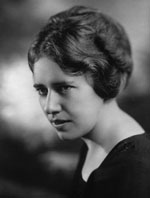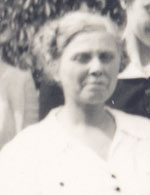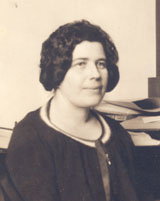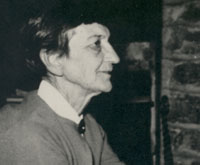Biographies
The First Woman Faculty Members of the Washington University School of Medicine
At the December 5, 1917 meeting of the Washington University School of Medicine’s Executive Faculty, no objection was raised to the idea that women could be given positions on the teaching staff of the Medical School. However, it was over a year before any woman would join the faculty of the school.
 |
| Kirsten Utheim Toverud (Photo courtesy of the Toverud family) |
Dr. W. McKim Marriott, professor of Pediatrics, proposed the appointment of Dr. Kirsten Utheim (1890-1949), a 1916 graduate of the University of Norway, as a fellow in Pediatrics, beginning April 1, 1919. In November of that year Utheim was promoted to assistant in Pediatrics, and her salary was doubled from $500 to $1,000 a year. In June 1920 Dr. Utheim was promoted to instructor in Pediatrics, and her salary doubled again to $2,000 a year. Utheim was also appointed a physician to Out Patients in the Washington University Dispensary that year. In December 1922 Utheim became the first woman physician appointed to a staff position in Pediatrics at both Barnes Hospital and St. Louis Children’s Hospital. In 1922 Utheim married Guttorm Toverud, a children’s dentist conducting research at Harvard University. On March 1, 1923, Toverud resigned her positions, and she and her husband returned to their native Norway, where both completed doctoral degrees at the University of Oslo in 1925. Kirsten Utheim Toverud served as associate pediatrician-in-chief at the National Hospital in Oslo and as associate professor of Physiology and Nutrition at the Dental School of Norway. She became known internationally for her long and distinguished career in the study and treatment of childhood diabetes and of maternal and child nutrition.
 |
| Irene Koechig, 1939 |
At the September 24, 1919 meeting of the Executive Faculty, Irene Koechig was appointed an assistant in Biological Chemistry. Koechig had received a bachelor’s degree from Washington University in 1911 and a master’s degree in Chemistry in 1912. Her salary for the academic year was $360, and she was expected to devote part of her time working in the metabolism ward in addition to the chemical laboratory. The following June Koechig was reappointed and her salary was raised to $750. Koechig was promoted to instructor in Biological Chemistry in 1928; she taught until the mid-1940s at the School of Medicine. From 1920 through the mid-1950s Irene Koechig taught chemistry and microbiology in the Washington University School of Nursing. Koechig authored several scientific articles as well as a textbook, Chemistry for Nurses, published in 1930. Koechig died in August 1975.
In 1983, Irene Koechig’s husband, George W. Freiberg, endowed the George William and Irene Koechig Freiberg Professorship in Biology at Washington University.
The following academic year, Beatrice Whiteside and Ethel Ronzoni joined the faculty as Instructors, Whiteside in Anatomy and Ronzoni in Biological Chemistry.
Beatrice Whiteside (1891-1971)
 |
| Beatrice Whiteside, early 1920s |
Beatrice Whiteside was born in Olean, New York on October 2, 1891. She graduated from Vassar College in 1913 and then spent several years in Zurich where she began the study of zoology in German. She completed her doctorate at the University of Zurich in 1920. Returning to the United States the next year, Whiteside busied herself catching up with the literature in her field in English and translating her thesis. In the summer of 1921, Dr. C. H. Danforth met her at Woods Hole and recommended her to his chief at Washington University, Dr. Robert J. Terry. Whiteside joined the faculty at Washington University as an instructor in anatomy and taught histology and neuroanatomy from 1921 until 1925. After working in St. Louis, Whiteside moved to the Detroit College of Medicine and Surgery (now Wayne State) as an associate professor of histology. Following her marriage, Whiteside returned to Europe in 1929 and became a volunteer research worker: the University of Berlin (1929-1930), the University of Vienna (1932-1938), and the University of Geneva (1942-1947), where French became her everyday language. Whiteside’s doctoral thesis dealt with the development of the endolymphatic sac in the frog, but in St. Louis she turned her attention to a comparison of the nucleic acid content of various tissues. In Detroit she studied the gustatory apparatus of the rat. During her “volunteer” days, Whiteside was concerned with the endocrine system in rabbits. When she was no longer associated with a laboratory, she explored the work of Paracelsus and produced a publication that described his influence on modern medicine.
Ethel Bishop Ronzoni (1892-1975)
 |
| Ethel Ronzoni |
Ethel Ronzoni was born on August 21, 1892 in California. She received a bachelor’s of science degree in Home Economics from Mills College in 1913 and a master’s degree in Education from Columbia University in 1914. Ronzoni then worked as an instructor of Home Economics at the University of Missouri – Columbia from 1914 to 1917, and was assistant professor of Home Economics at the University of Minnesota for the 1917-18 academic year. She then entered the University of Wisconsin and earned a doctorate in Physiology in 1923. While at Wisconsin, Ronzoni met and married George H. Bishop, who was there studying zoology.
In 1921 the couple moved to St. Louis and both joined the faculty of the Washington University School of Medicine. Ronzoni (“Ronnie” to her husband and friends) was promoted to assistant professor of Biological Chemistry in Neuropsychiatry in 1930, and to associate professor of Biological Chemistry in Neuropsychiatry in 1954. She retired as associate professor emeritus of Biochemistry in Psychiatry and Neurology in 1959, though she continued to work in her lab until the mid-1960s. Ronzoni’s research interests included carbohydrate metabolism and muscle biochemistry. She authored or contributed to over 30 scientific publications during her career.
Related Links:
Return to WUMC Faculty/Staff (Biographies)
Return to All Biographies
Back to Top
